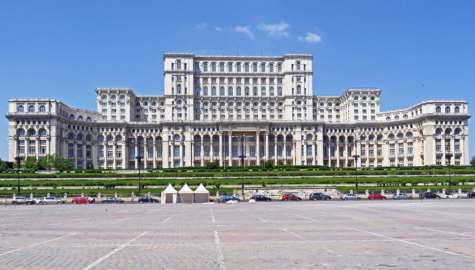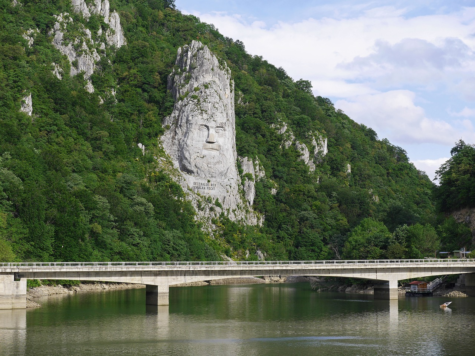Country Curiosities: Romania
June 5, 2021
Introduction
When it comes to Western Europe, the average person can easily talk about interesting facts they may have learned, trends they’re following, or even current events about this part of the European continent. Look more eastward though, and the average person will find difficulty in talking about countries further east than Poland. That is not to say, however, that these places are devoid of anything interesting or worthy of mention. Romania, for instance, located right south of Ukraine and north of Bulgaria, boasts some of its own stunning accomplishments and curiosities. From being the actual hometown of Sasha Baron Cohen’s successful yet controversial character Borat to having the world’s longest sausage (at 39 miles long), Romania is not a country to simply dismiss as just another part of the widely underrated Eastern European cluster (Smith).
World’s Heaviest Building
Upon stepping foot into a building, your first thought typically isn’t wondering how heavy the building is or where it ranks on the “World’s Heaviest Buildings” list–which is apparently a thing. According to most sources which for some reason keep track and rank the heaviest buildings in the world, the Palace  of Parliament building in Romania’s capital, Bucharest, is the heaviest building in the world. In the official Guinness World Record for the World’s Heaviest Building, the building consists of 700,000 tons of steel and bronze, 35.3 million ft3 of marble, 3,500 tons of crystal glass, and 31.7 million ft3 of wood (Guinness World Records). To put this into perspective, the Statue of Liberty reportedly weighs 62,000 lbs, according to the National Park Service, meaning that the Palace of Parliament weighs slightly more than 145,162 Lady Liberties.
of Parliament building in Romania’s capital, Bucharest, is the heaviest building in the world. In the official Guinness World Record for the World’s Heaviest Building, the building consists of 700,000 tons of steel and bronze, 35.3 million ft3 of marble, 3,500 tons of crystal glass, and 31.7 million ft3 of wood (Guinness World Records). To put this into perspective, the Statue of Liberty reportedly weighs 62,000 lbs, according to the National Park Service, meaning that the Palace of Parliament weighs slightly more than 145,162 Lady Liberties.
Count Dracula’s Hometown
In ancient times, creatures from mythology such as nymphs, kappas, centaurs, and especially vampires were perceived as being real. Unfortunately, as people soon came to realize that these unnatural creatures were… unnatural, they began to fantasize and romanticize the idea of them to the point where they no longer give off an aura of fear, but instead draw upon different emotional reactions. Vampires, for instance, have been romanticized in shows, movies, and television, where they’ve gone from being seen as carnations of the devil himself to emo teens dressed in all black with too much eyeshadow. Despite this, one vampire story still remains true to tradition and remains as one of the most, if not the most, popular single mythological creature around the world. Of course, it could only be Count Dracula himself. The original story for Count Dracula is actually based off of and takes heavy influence from Vlad the Impaler of Romania, who was infamous for torturing his enemies (Pallardy). It is even believed that the actual castle from which the fictional Dracula is said to reside is Bran Castle, which is not far from the capitol (“Count Dracula…).
were perceived as being real. Unfortunately, as people soon came to realize that these unnatural creatures were… unnatural, they began to fantasize and romanticize the idea of them to the point where they no longer give off an aura of fear, but instead draw upon different emotional reactions. Vampires, for instance, have been romanticized in shows, movies, and television, where they’ve gone from being seen as carnations of the devil himself to emo teens dressed in all black with too much eyeshadow. Despite this, one vampire story still remains true to tradition and remains as one of the most, if not the most, popular single mythological creature around the world. Of course, it could only be Count Dracula himself. The original story for Count Dracula is actually based off of and takes heavy influence from Vlad the Impaler of Romania, who was infamous for torturing his enemies (Pallardy). It is even believed that the actual castle from which the fictional Dracula is said to reside is Bran Castle, which is not far from the capitol (“Count Dracula…).
A Ripoff Rushmore
 Mount Rushmore stands as a monument to some of the great presidents of the United States who, through unrelenting resolve and dedication, brought widespread prosperity to the country and overcame the issues of their time. In Romania, there stands a similar monument with a similar purpose, to memorialize an important cultural figure in stone; to etch their culture into the Earth itself. The statue of King Decebal (pronounced De-Che-Bal, not decibel) in Romania depicts the last King of Dacia, who fought three wars against two Roman emperors who sought to conquer modern day Romania (Atlas Obscura). The statue is regarded as Europe’s largest rock sculpture, standing 40 meters tall and taking ten years to complete, from 1994 to 2004 (Atlas Obscura).
Mount Rushmore stands as a monument to some of the great presidents of the United States who, through unrelenting resolve and dedication, brought widespread prosperity to the country and overcame the issues of their time. In Romania, there stands a similar monument with a similar purpose, to memorialize an important cultural figure in stone; to etch their culture into the Earth itself. The statue of King Decebal (pronounced De-Che-Bal, not decibel) in Romania depicts the last King of Dacia, who fought three wars against two Roman emperors who sought to conquer modern day Romania (Atlas Obscura). The statue is regarded as Europe’s largest rock sculpture, standing 40 meters tall and taking ten years to complete, from 1994 to 2004 (Atlas Obscura).
Atlas Obscura. “Decebal’s Head.” Atlas Obscura, Atlas Obscura, 24 Aug. 2009, www.atlas obscura.com/places/decebals-head.
“Count Dracula // The Myth.” Dracula – Bran Castle, Bran Castle, www.bran-castle.com/dracula .html.
Guinness World Records. “Heaviest Building.” Guinness World Records, www.guinnessworld records.com/world-records/heaviest-building.
National Parks Service. “Statue Statistics.” National Parks Service, U.S. Department of the Interior, www.nps.gov/stli/learn/historyculture/statue-statistics.htm.
Pallardy, Richard. “Vlad the Impaler”. Encyclopedia Britannica, 5 Jan. 2021, https://www .britannica .com/biography /Vlad-the-Impaler. Accessed 4 June 2021.
Smith, Oliver. “17 Fascinating Facts about Romania, Home of the World’s Heaviest Building.” The Telegraph, Telegraph Media Group, 10 May 2017, www.telegraph.co.uk/travel/destin ations/europe/romania/articles/romania-amazing-facts/.






















































